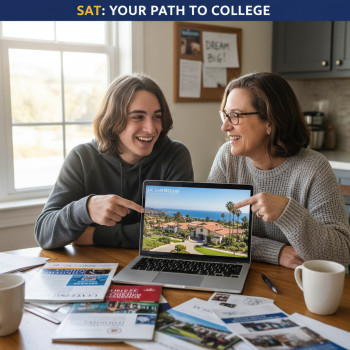AP vs SAT: What Every Humanities Applicant and Parent Should Know
If you re a student who lives and breathes history essays, close readings of poetry, and lively classroom debates or a parent cheering from the sidelines this post is for you. Choosing between leaning into Advanced Placement (AP) exams or polishing your Digital SAT performance isn t an either/or for many applicants; it s a strategic decision. Which will best show colleges what you can do? How do you allocate your time, energy, and resources? Below I ll walk you through why each path matters, present three realistic humanities applicant case studies, and offer practical study plans (including how Sparkl s personalized tutoring can fit in naturally) so you and your family can decide confidently.

Quick Primer: How AP Exams and the Digital SAT Differ (and Overlap)
Before we get into case studies, let s clarify what each assessment is built to show. These tests aren t identical, but they overlap in useful ways.
AP Exams Depth, Course Work, and College Credit Potential
AP courses are yearlong, classroom-based experiences culminating in an AP Exam, scored 1 5. For humanities students, the most relevant are AP English Language, AP English Literature, AP United States History, AP World History, AP European History, AP Government and Politics, and social science electives like AP Psychology. Many colleges grant credit or placement for scores of 3 or higher (policies vary by institution), which can mean skipping introductory courses or demonstrating readiness for more advanced work.
Digital SAT Broad College Readiness and Comparative Marker
The Digital SAT focuses on Reading and Writing and Math, and while it s shorter than earlier paper tests and delivered on a secure digital platform, it is still widely used in admissions as a standard comparator across applicants. For humanities students, the Reading and Writing section offers the clearest opportunity to showcase textual analysis, vocabulary-in-context, and argument skills in a succinct, timed format.
Where They Overlap
- Both signal academic readiness to colleges.
- Both reward strong reading comprehension, clear writing, and critical thinking skills central to humanities applicants.
- Both can be part of a balanced admissions profile: APs for demonstrated mastery in a subject; SAT for cross-applicant comparison.
Case Study Framework: Meet Three Humanities Applicants
Rather than abstract arguments, let’s look at three realistic students. These case studies are composites built from patterns admissions officers often see. Each includes context, pros and cons of prioritizing AP vs SAT, and an actionable plan.
Case Study 1 Maya: The Deep-Dive Essayist
Profile: Maya is a junior passionate about literature and comparative cultural studies. She s taking AP English Literature, AP European History, and AP Spanish. Her GPA is strong (3.9 weighted), but her school doesn t offer a ton of AP sections. She enjoys crafting extended essays and consistently gets high marks on analytical projects.
Strategy Considerations:
- AP Strengths: Maya s classroom work aligns perfectly with AP Literature and History tasks, which allow her to produce sustained analysis and showcase her writing voice in extended responses. High AP scores could lead to college credit and demonstrate subject mastery.
- SAT Strengths: A strong Digital SAT Reading and Writing score would provide a standardized measure that admissions teams can easily compare across applicants, especially if Maya wants to apply to selective programs.
Recommended Plan (Junior Year):
- Primary focus: AP exam preparation for AP Literature and AP European History. Use class time efficiently to collect strong writing samples for college applications and practice timed free-response questions.
- Secondary focus: Take a diagnostic Digital SAT in the spring to identify gaps. Spend 6 8 weeks in the summer on SAT-specific practice (timing, question types) with weekly full-section digital practice.
- Supplement: 1-on-1 tutoring sessions twice a month to refine thesis development and timed essay mechanics Sparkl s personalized tutoring can step in here with tailored study plans and expert tutors who bridge AP essay expectations and SAT writing demands.
Case Study 2 Noah: The Broad Humanities Enthusiast
Profile: Noah loves history and political thought. He s taking AP US History, AP Government, and AP Psychology. His GPA is solid (3.6 weighted). He s active in debate and Model UN. He s not sure whether to aim for top-tier selective schools or solid public universities, and his timeline includes a fall Digital SAT attempt senior year.
Strategy Considerations:
- AP Strengths: AP US History and Government align with Noah s interests and extracurriculars. Strong AP scores reinforce his subject-specific commitment.
- SAT Strengths: A competitive Digital SAT offers broad credibility especially important if Noah applies to out-of-state public universities that expect a strong standardized benchmark.
Recommended Plan (Sophomore to Senior Year):
- Start early: Begin targeted SAT prep in junior spring while taking AP courses 12-week SAT prep blocks that focus on reading stamina and passage strategy are ideal.
- Leverage AP work: Use AP exam study (document analysis for history essays, DBQs) to sharpen evidence-based writing skills that translate to SAT Reading questions and the application essays.
- Personalized help: For Noah, occasional focused Sparkl tutoring (drills for timed reading passages, tailored practice quizzes) can close score gaps efficiently without overwhelming his AP workload.
Case Study 3 Lina: The Late Bloomer with a Strong Senior Year Plan
Profile: Lina s school offers few APs, and she discovered a love for literature later in high school. She has a 3.5 GPA and wants to aim for selective liberal arts colleges, but senior year will be her strongest academic push. She plans to take AP English Language as a self-study, and she s nervous about the Digital SAT.
Strategy Considerations:
- AP Strengths: Self-studying an AP can be powerful when paired with strong writing samples and teacher recommendations that reflect growth.
- SAT Strengths: A solid Digital SAT score can offset a slimmer AP transcript, providing a comparable metric for admissions readers.
Recommended Plan (Senior Year Timeline):
- Fall: Intensive SAT prep (take the test early to allow for retake). Use practice tests to identify pacing and comprehension weaknesses.
- Winter/Spring: Self-study AP English Language via college-level syllabi and past free-response questions. Schedule mock AP exams and get feedback from a tutor or English teacher.
- Support: Regular 1-on-1 Sparkl sessions for essay feedback and an individualized study plan: one coach helps with AP free-response practice while another targets SAT reading strategies. That cross-reference is highly efficient for juniors and seniors juggling many priorities.
Practical Comparison: How AP and SAT Scores Are Used in Admissions
Colleges use AP and SAT scores differently. AP scores can translate to credit or placement (if the college accepts them), and they also show mastery in a given subject. Digital SAT scores provide a normalized gauge to compare applicants from diverse schools. For humanities applicants, the strongest profile often combines both: AP scores that show sustained achievement in literature or history plus an SAT score that highlights reading and analytic strength.
| Feature | AP Exams | Digital SAT |
|---|---|---|
| Typical Score Range | 1 5 | 400 1600 |
| Demonstrates | Depth in a subject, coursework mastery | General college readiness across applicants |
| Best for | Subject credit/placement; evidence of taking college-level coursework | Comparative admissions benchmark; scholarship eligibility at some schools |
| When to prioritize | When you want to show specialty in humanities; your school supports strong AP instruction | When you need a cross-school comparator or to strengthen a transcript without many APs |
Study Plans That Work for Humanities Students
Whether you prioritize AP exams, the Digital SAT, or both, your study plan should be tailored to your strengths, timeline, and application goals. Here are concrete plans you can adapt.
Plan A: AP-Forward (For Students Taking Multiple APs)
- Timeline: Junior year focus for AP classwork; AP-specific practice starting in January leading to May exams.
- Weekly Routine: 5 7 hours of reading and writing practice (mix of class assignments, past AP free-response questions, and secondary-source analysis).
- Digital SAT Integration: Take a diagnostic in spring. Use 6 8 weeks in the summer for SAT-specific practice (timing strategies, digital interface practice), then consider a fall test date senior year to solidify a standardized score.
- Tutor Role: A tutor (or Sparkl s expert tutors) can provide targeted essay feedback and mock AP scorings, bridging classroom feedback and college exam expectations.
Plan B: SAT-First (For Students Needing a Comparative Score)
- Timeline: Intensive SAT prep junior spring summer with the goal of an early senior year test date and retake if needed.
- Weekly Routine: 6 10 hours of structured practice timed sections, vocabulary-in-context drills, and reading comprehension from varied humanities sources (essays, primary sources, literary passages).
- AP Integration: Pick 1 2 APs that align with strengths; use AP prep for long-form writing practice after SAT baseline is secure.
- Tutor Role: Short, focused Sparkl sessions aimed at pacing, passage strategy, and converting reading strengths into higher SAT scores.
Plan C: Balanced (For Students Who Want the Best of Both)
- Timeline: Alternate blocks AP deep work in the academic term; SAT focused blocks during breaks and the summer.
- Weekly Routine: 4 6 hours of AP-focused practice plus 3 5 hours of SAT drills; prioritize quality over quantity.
- Tutor Role: A blended tutoring plan (Sparkl s tailored study plans are ideal here) that assigns homework, tracks progress with AI-driven insights, and adapts weekly based on performance results.
Admissions-Ready Writing: Bridging AP Essays and College Application Essays
One beautiful advantage for humanities applicants is that AP essay practice and college application essays reinforce each other. AP essays train you to craft thesis-driven arguments with textual evidence; college essays need those same clarity, structure, and voice cues, but with more personal reflection. Use AP free-response prompts as training grounds for tight argumentation, and then translate the storytelling and reflection to your college personal statement.
Real-World Tips for Parents and Students
- Start with goals: Are you aiming for placement/credit, or do you need a standardized benchmark to strengthen your application? That answer guides everything.
- Quality beats quantity: A few well-executed APs and a solid SAT score often beat a long list of half-prepared exams.
- Practice the medium: For the digital SAT, practice on the actual digital interface. For APs, practice full free-response questions under timed conditions.
- Track test dates and deadlines: AP registrations go through your school; SAT dates require advance registration and practice schedules. Plan retakes if needed.
- Consider targeted tutoring: If you re balancing schoolwork, extracurriculars, and test prep, 1-on-1 guidance can accelerate growth. Sparkl s personalized tutoring tailored study plans, expert tutors, and AI-driven insights fits naturally here, offering focused help without unnecessary time costs.
Putting Numbers in Perspective: What Admissions Officers See
Admissions teams look at APs as evidence you pursued challenging coursework. A string of strong AP scores in core humanities subjects signals readiness for major-level classes. A competitive Digital SAT Reading and Writing section score indicates you can handle the dense reading common in college seminars. Neither score guarantees admission, but together they build a persuasive academic narrative.
Checklist: How to Decide Your Best Path
- Inventory your schedule: Do you have time for AP coursework and exam prep? If so, APs may be your priority.
- Benchmark your skills: Take both a sample AP free-response and a Digital SAT diagnostic to see which test better captures your strengths.
- Map to your target colleges: Check each college s AP credit policy and typical admitted SAT ranges use that to weigh each option.
- Plan for fallback: If you can only do one well before applications, choose the one that most clearly addresses your weaknesses on your application.
Final Thoughts: Craft Your Story, Don t Choreograph Tests
At their best, tests and exams are tools to tell the story of your curiosity, discipline, and potential. For humanities applicants, AP exams let you demonstrate sustained engagement and subject mastery; the Digital SAT offers a clear, comparative indicator of reading and analytic skill. Often, the best strategy mixes both use APs to show depth and the SAT to provide a common yardstick. And remember: a thoughtful study plan, realistic timeline, and occasional personalized help like focused 1-on-1 sessions and tailored study plans will get you farther than trying to do everything at once.

Resources and Next Steps
Make a small plan today: take a diagnostic Digital SAT, write one timed AP-style essay, and schedule a conversation with a counselor or tutor about aligning test choices with your college list. If you want a tailored plan, a short consultation with a specialist can map out the most efficient path whether that s a Sparkl coaching block focused on AP essay scoring or focused digital SAT strategy sessions. The right plan will respect your voice, your calendar, and your appetite for challenge.
Parting Encouragement
This process can feel heavy because it matters but remember that tests are only part of a bigger story. Your classroom engagement, recommendations, essays, and extracurricular curiosity matter just as much. Take steady steps: practice consistently, ask for targeted feedback, and let your unique perspective on the humanities shine through in every answer you write and every score you earn.
If you d like, I can help draft a personalized 12-week study calendar for one of the case studies above, or build a diagnostic plan based on your current scores and commitments. Just tell me which student profile matches you most closely, and we ll sketch a plan together.



















No Comments
Leave a comment Cancel